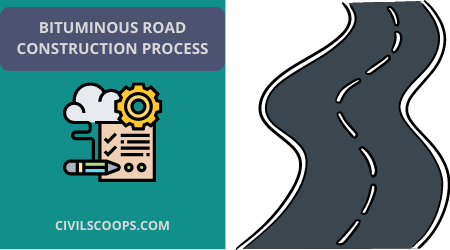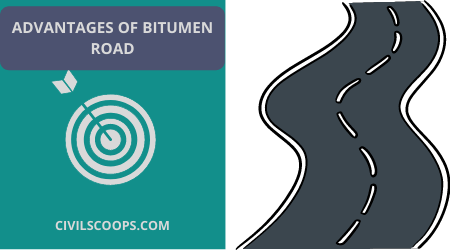What Is Bituminous Road? | Bituminous Road Construction | Bituminous Road Layers | Bituminous Macadam | Bituminous Road Construction Process | Advantages of Bitumen Road | Disadvantages of Bitumen Road | Application Road
Table of Contents
What Is Bituminous Road?
- Bitumen is dark viscous material which is sticky in nature, it mainly founds in natural deposits. Generally, a bituminous road surface is made of bitumen material.
- Now a days these roads are constructed because of low initial cost and low maintenance cost.
- Bituminous roads also produce less sound with compare to concrete roads.
- Bituminous roads have various advantages and different properties, that’s why now we are using this type of bituminous roads.
Application of Bitumen Roads
- Bituminous is the by-product of the distilling crude oil, it contains hydrocarbons. Petrol, gasoline is the main products that are obtained from crude oil.
- Now a days bitumen is also used as a construction material.
- Bitumen has the property of temperature resisting so thermoplastic substances are made by this product.
- Bitumen has melting point so that it has both wearing resistance and surface dressing property.
- Bituminous melted and it goes back to its original position and this is called asphalt recycling.
- Sometimes torn-up asphalt parts are mixed with the new bitumen with aggregates and used for construction work. This is totally free from hydrocarbons and it is not harmful.
Bituminous Road Construction
There are mainly six steps are followed to construct the bituminous road, those are-
- Preparation of the Existing Base Layer Course
- Application of Tuck Coat
- Preparation and Placing of Premix
- Rolling
- Quality Control of Bituminous Concrete Construction
- Finished surface
1. Preparation of the Existing Base Layer Course
- In the first step, you need to remove the potholes and clear the rust portion from the road.
- Then before laying that layer we need to fill up those portions by chipping.
- At last, the bituminous course is provided with the binding material with an adequate thickness. We do not lay the bituminous layer directly on the WBM.
2. Application of Tuck Coat
- It is a bituminous course which is used for binder course normally.
- This tuck coat is naturally applied with a range of 6 to 7.5 kg per sq. m.
- Sometimes this range is also increased to 7.5 to 10 kg.
3. Preparation and Placing of Premix
- The premix is prepared from the mixing plant at a high temperature.
- In the hot mix plant, the bitumen is heated up with a temperature of 155-175°C. Heated bitumen is then collected from the plant and transported by the small cart to spread at the mechanical paver at a temperature of 121-163°C.
- Here the camber height is properly maintained and the heating temperature directly responds to the longevity of the bitumen road.
4. Rolling
- After the mix is properly placed then the rolling process is started; the rolling speed is not more than 5km per hour.
- This rolling process is done by three different rolling processes. The initial rolling process is done by an 8 to 12-ton roller.
- Now the intermediate rolling process is done by a fixed wheel pneumatic roller of 15 to 30 tons which has a tyre pressure of 7 kg per sq.m.
- The roller wheels are damped with the water. In the hot weather, rolling is done the next day to provide some time to increase the density of the material.
- The final rolling or finishing work is done by a tandem roller of 8 to 10 tons.
5. Quality Control of Bituminous Concrete Construction
- To ensure the pavement surface and pavement mixture quality a routine check is performed.
- These routine checks are- a) Aggregate grading b) Grade of bitumen c) Temperature of aggregated) The temperature of paving mix during mixing and compaction.
- Out of every 100 tons, one sample is collected for testing. Marshall test is also conducted for every 100 m. surface. It is mainly done to check out the density of the material in the laboratory.
- The thickness variation is allowed is 6 mm per 4.5 m length of the construction.
6. Finished surface
- This surface is checked by a 3 m straight edge. The longitudinal undulations should not exceed 8 mm.
- The number of undulations higher than 6mm, should not exceed 10 in a length of 300mm.
- The undulation of cross-traffic should not exceed 4 mm.
Bituminous Road Layers
Bituminous road layers are divided into three parts, those are-
- Bituminous Base Course: This is the bottom-most part of the bituminous road. This layer is consist of mineral aggregates which is mixed up with bituminous materials such as asphalt, stones, sand, etc. This coat mainly acts as a binder coarse.
- Bituminous Binder Course: This is an intermediate layer that is sandwiched between the base course and a surface layer. This is a two-layer surfacing coat. This binder course is also called a levelling course which is composed of a bituminous aggregate mixture.
- Bituminous Concrete Layer: In this course, a mixture of the aggregate layers is provided with a size of less than 25 mm 0.075 mm. We need to add more bitumen to make this impervious and more elastic property.
Bituminous Macadam
- Bituminous macadam is containing crushed aggregates, a heated bituminous binder which is mixed in a hot mix plant with a higher temperature and after that, it is transported to the construction site.
- The mixture is laid with a mechanical paver and compacted by a roller.
- We need to lay the BM in a compact thickness of 50 mm to 100 mm. IRC provides two different grades of aggregate for the base course of the highway pavement.
- After that, some surfacing coarse is applied over the base material.
- If the delay happens to provide the bituminous layer then a seal coat is applied on it to protect the road from disturbing water.
- This base material has good load distribution property rather than other materials like WMM or WBM.
- When granular base coarse is provided then the ratio of the BM base course is 1.5m.
Bituminous Road Construction Process

There are mainly six steps are followed to construct the bituminous road, those are-
- Preparation of the Existing Base Layer Course
- Application of Tuck Coat
- Preparation and Placing of Premix
- Rolling
- Quality Control of Bituminous Concrete Construction
- Finished Surface
1. Preparation of the Existing Base Layer Course
- In the first step, you need to remove the potholes and clear the rust portion from the road.
- Then before laying that layer we need to fill up those portions by chipping.
- At last, the bituminous course is provided with the binding material with an adequate thickness. We do not lay the bituminous layer directly on the WBM.
2. Application of Tuck Coat
- It is a bituminous course which is used for binder course normally.
- This tuck coat is naturally applied with a range of 6 to 7.5 kg per sq. m.
- Sometimes this range is also increased to 7.5 to 10 kg.
3. Preparation and Placing of Premix
- The premix is prepared from the mixing plant at a high temperature.
- In the hot mix plant the bitumen is heated up with a temperature of 155-175°C. Heated bitumen is then collected from the plant and transported by the small cart to spread at the mechanical paver at a temperature of 121-163°C.
- Here the camber height is properly maintained and the heating temperature directly responds to the longevity of the bitumen road.
4. Rolling
- After the mix is properly placed then the rolling process is started; the rolling speed is not more than 5km per hour.
- This rolling process is done by three different rolling processes. The initial rolling process is done by an 8 to 12-ton roller.
- Now the intermediate rolling process is done by a fixed wheel pneumatic roller of 15 to 30 tons which has a tyre pressure of 7 kg per sq.m.
- The roller wheels are damped with the water. In the hot weather rolling is done in the next day to provide some time to increase the density of the material.
- The final rolling or finishing work is done by a tandem roller of 8 to 10 tons.
5. Quality Control of Bituminous Concrete Construction
- To ensure the pavement surface and pavement mixture quality a routine check is performed.
- These routine checks are- a) Aggregate grading b) Grade of bitumen c) Temperature of aggregated) The temperature of paving mix during mixing and compaction.
- Out of every 100 tons, one sample is collected for testing. Marshall test is also conducted for every 100 m. surface. It is mainly done to check out the density of the material in the laboratory.
- The thickness variation is allowed is 6 mm per 4.5 m length of the construction.
6. Finished Surface
- This surface is checked by a 3 m straight edge. The longitudinal undulations should not exceed 8 mm.
- The number of undulations higher than 6mm, should not exceed 10 in a length of 300mm.
- The undulation of cross-traffic should not exceed 4 mm.
Advantages of Bitumen Road

- Bituminous roads do not have any joints, it gives us a flat surface with compare to the concrete roads.
- Bituminous roads also produce less noise rather than concrete roads. In bituminous pavements, the wear and tear is also less.
- The failure of the bituminous pavement is also a gradual process.
- The maintenance process of this type of road is very fast and the set out time of the bituminous pavement is also very quick.
- The initial cost and the maintenance cost of the bituminous pavement are less with compare to the concrete pavement.
- They have very high melting temperature and it is not impacted by de-icing materials.
Disadvantages of Bitumen Road

- The bituminous road surface is less durable compare to the concrete surface. The tensile strength of the bituminous road is also very less.
- In extreme weather conditions, the bituminous roads get slippery and porous.
- Impurity bitumen can cause of soil contamination which affects the ground water.
- It has high construction costs in extreme temperature conditions.
[note note_color=”#F2F2F2 ” text_color=”#333333″ radius=”3″ class=”” id=””]
Like this post? Share it with your friends!
Suggested Read –
- What Is Super Elevation? | Superelevation Definition | Purpose of Providing Superelevation in Roads | Calculation of Superelevation in Roads | Minimum and Maximum Superelevation in Roads | Method of Providing Superelevation to the Roads
- What Is Lintel? | Function of Lintel | Types of Lintel
- What Is Grouting | Type of Grouting | Experiment of Grouting | Characteristics of Grouting | Types of Grout for Ceramic Tile | Advantage of Grouting | Disadvantage of Grouting
- What Is Grade of Concrete | Concrete Mix Ratio | Type of Concrete Mix | Different Types of Concrete Grade with Concrete Mix Ratio and Compressive Strength | Uses of Different Grades of Concrete
- What Is Hidden Beam | Why Is It Used | Where Is It Used in Buildings | How to Design a Hidden Beam | Purpose of Hidden Beam | Advantages of Hidden Beam | Disadvantages of Hidden Beam
[/note]
Originally posted 2021-07-28 12:54:44.

